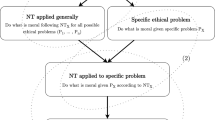Abstract
This article is an exercise in computational jurisprudence. It seems clear thatthe field of AI and Law should draw upon the insights of legal philosophers,whenever possible. But can the computational perspective offer anything inreturn? I will explore this question by focusing on the concept of OWNERSHIP,which has been debated in the jurisprudential literature for centuries. Althoughthe intellectual currents here flow mostly in one direction – from legal philosophy to AI – I will show that there are also some insights to be gained from a computational analysis of the OWNERSHIP relation. In particular, the article suggests a computational explanation for the emergence of abstract property rights, divorced from concrete material objects.
Similar content being viewed by others
References
Ackerman, B. A. ed. (1975). Economic Foundations of Property Law. Little, Brown and Co.
Ackerman, B. A. (1977). Private Property and the Constitution. Yale University Press.
Ames, J. B. (1913). The Disseisin of Chattels. In Lectures in Legal History, 172–191. Harvard University Press.
Blackstone, W. (1791). Commentaries on the Laws of England. 11th edition. London.
Brachman, R. J., Fikes, R. E., and Levesque, H. J. (1985). KRYPTON: A Functional Approach to Knowledge Representation. In Brachman, R. J. and Levesque, H. J., (eds.) Readings in Knowledge Representation, 411–429. Morgan Kaufmann.
Demsetz, H. (1967). Toward a Theory of Property Rights. American Economic Review, Papers and Proceedings 57: 347–359.
Demsetz, H. (1982). Professor Michelman's Unnecessary and Futile Search for the Philosopher's Touchstone. In Pennock, J. R. and Chapman, J. W. (eds.) Nomos XXIV: Ethics, Economics, and the Law. New York University Press.
Donahue, Jr. C. (1980). The Future of the Concept of Property Predicted from its Past. In Pennock, J.R. and Chapman, J. W. (eds.) Nomos XXII: Property, 28–68. New York University Press. Papers presented at a meeting of the American Society for Political and Legal Philosophy, 1977.
Grey, T. C. (1980). The Disintegration of Property. In Pennock, J. R. and Chapman, J. W. (eds.) Nomos XXII: Property, 69–85. New York University Press. Papers presented at a meeting of the American Society for Political and Legal Philosophy, 1977.
Hart, H. L. A. (1984). Definition and Theory in Jurisprudence. In Essays in Jurisprudence and Philosophy, 21–48. Oxford University Press.
Herrestad, H. and Krogh, C. (1995). Obligations Directed from Bearers to Counterparties. In Proceedings of the Fifth International Conference on Artificial Intelligence and Law, 210–218. ACM Press.
Hohfeld, W. H. (1909). The Nature of Stockholders' Individual Liability for Corporation Debt. Columbia Law Review 9: 285.
Hohfeld, W. H. (1913). Some Fundamental Legal Conceptions as Applied in Judicial Reasoning. Yale Law Journal 23: 16.
Hohfeld, W. H. (1917). Fundamental Legal Conceptions as Applied in Judicial Reasoning. Yale Law Journal 26: 710.
Hohfeld, W. H. (1964). Fundamental Legal Conceptions, vii- xv. Yale University Press. Foreword by Arthur L. Corbin.
Honoré, A. M. (1961). Ownership. In Guest, A. G. (ed.), Oxford Essays in Jurisprudence, 107–147. Oxford University Press.
Jones, A. J. I. and Sergot, M. (1996). A Formal Charaterization of Institutionalized Power. Journal of the IGPL 4: 429–445.
Lindahl, L. (1977). Position and Change: A Study in Law and Logic. D. Reidel.
McCarty, L. T. and Sridharan, N. S. (1981). The Representation of an Evolving System of Legal Concepts: II. Prototypes and Deformations. In Proceedings of the Seventh International Joint Conference on Artificial Intelligence, 246–253.
McCarty, L. T. and van der Meyden, R. (1991). Indefinite Reasoning with Definite Rules. In Proceedings of the Twelfth International Joint Conference on Artificial Intelligence, 890–896.
McCarty, L. T. and van der Meyden, R. (1992). Reasoning about Indefinite Actions. In Principles of Knowledge Representation and Reasoning: Proceedings of the Third International Conference (KR92), 59–70. Morgan Kaufmann.
McCarty, L. T. (1977). Reflections on TAXMAN: An Experiment in Artificial Intelligence and Legal Reasoning. Harvard Law Review 90: 837–893.
McCarty, L. T. (1980). The TAXMAN project: Towards a Cognitive Theory of Legal Argument. In Niblett, B. (ed.) Computer Science and Law: An Advanced Course, 23–43. Cambridge University Press.
McCarty, L. T. (1983). Permissions and Obligations. In Proceedings of the Eighth International Joint Conference on Artificial Intelligence, 287–294.
McCarty, L. T. (1986). Permissions and Obligations: An Informal Introduction. In Martino, A. A. and Socci Natali, F. (eds.) Automated Analysis of Legal Texts: Logic, Informatics, Law, 307–337. Elsevier North-Holland. Also available as Rutgers Technical Report LRP-TR-19.
McCarty, L. T. (1989). A Language for Legal Discourse. I. Basic Features. In Proceedings of the Second International Conference on Artificial Intelligence and Law, 180–189. ACM Press.
McCarty, L. T. (1993). Circumscribing Embedded Implications (without Stratifications). Journal of Logic Programming 17: 323–364.
McCarty, L. T. (1995). An Implementation of Eisner v. Macomber. In Proceedings of the Fifth International Conference on Artificial Intelligence and Law, 276–286. ACM Press.
Michelman, F. I. (1982). Ethics, Economics, and the Law of Property. In Pennock, J. R. and Chapman, J. W. (eds.) Nomos XXIV: Ethics, Economics, and the Law. New York University Press.
Munzer, S. R. (1990). A Theory of Property. Cambridge University Press.
Posner, R. A. (1973). Economic Analysis of Law. Little, Brown and Co.
Schlobohm, D. A. and McCarty, L.T. (1989). EPS-II: Estate Planning with Prototypes. In Proceedings of the Second International Conference on Artificial Intelligence and Law, 1–10. ACM Press.
Smith, J. C. (1976). Legal Obligation. The Athlone Press, University of London.
Author information
Authors and Affiliations
Rights and permissions
About this article
Cite this article
McCarty, L.T. Ownership: A case study in the representation of legal concepts. Artificial Intelligence and Law 10, 135–161 (2002). https://doi.org/10.1023/A:1019584605638
Issue Date:
DOI: https://doi.org/10.1023/A:1019584605638




